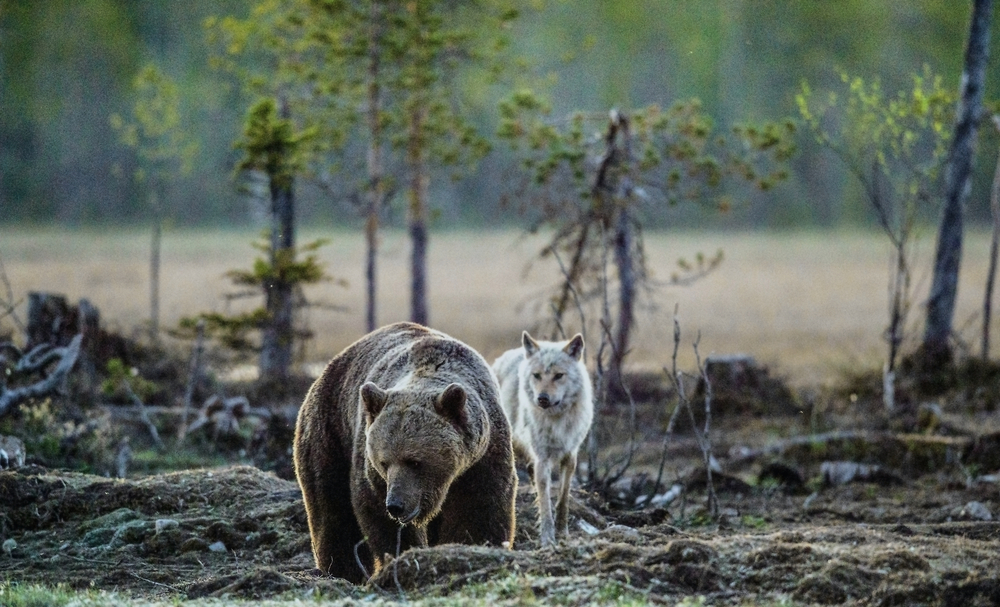This wolf and bear pair were recorded traveling and hunting together

Imagine walking through a dense forest, where the rustling of leaves and the distant calls of wildlife echo through the air. In this vast wilderness, the idea of two apex predators—one representing the strength and solitude of a bear, the other the sharp coordination and instinct of a wolf—collaborating on a hunt seems impossible. Yet, in an unexpected twist of nature, this very scenario has been documented. Wolves and bears, two formidable creatures, have been seen not only coexisting but cooperating in the wild. Is it mere coincidence, or is there something deeper at play in their unlikely partnership?
This fascinating bond challenges the typical narrative of competition in the animal kingdom. It’s a story that forces us to reconsider the boundaries of survival and the ways in which even the most unlikely alliances can emerge. What drives these creatures to put aside their natural instincts and work together? And more importantly, what can we learn from their behavior that might change the way we think about cooperation, survival, and interdependence in our own lives?

The Discovery: A Photographer’s Observation
In the vast and untamed wilderness, there are moments that even the most seasoned wildlife observers find difficult to believe. Imagine a photographer, dedicated to capturing the raw beauty of nature, stumbling upon a scene so unexpected it almost seems scripted—wolves and bears, two apex predators with seemingly irreconcilable differences, traveling and hunting together. This rare moment, captured on film, goes beyond the typical wildlife encounter; it offers a glimpse into a behavior that is as fascinating as it is perplexing. What makes this discovery so captivating is that it wasn’t just a fleeting moment—this cooperation was documented multiple times, showcasing an unusual, yet undeniable connection between the two species.
The photographer’s documentation reveals a strikingly peaceful coexistence between the wolves and the bears. In a world where animals are often seen as fierce competitors for food and territory, this dynamic defies what we traditionally believe to be the nature of predator behavior. While these animals are typically solitary in their approach to hunting and survival, here, they seem to have transcended their natural instincts. As the photographer observed, the wolves and bears were not just tolerating each other—they were actively sharing the same space, moving through the forest in a coordinated manner. It was clear that something was different about this interaction, and the images taken tell a compelling story of interspecies harmony that has captivated wildlife enthusiasts and researchers alike.
Beyond the awe of the discovery, the significance lies in how this rare event challenges our preconceived notions of nature. The wild is often portrayed as a battleground where only the strongest survive, but these images tell a different story—one of collaboration, adaptability, and perhaps, mutual benefit. It’s not just a snapshot of an unusual moment in time; it’s an invitation to rethink how we understand relationships in the natural world and, by extension, in our own lives.

The Relationship: Cooperation or Necessity?
For years, researchers have observed the intricate and often harsh dynamics that define life in the wild, particularly between predators. Wolves, known for their highly social packs, rely on cooperation and strategy to hunt, taking down prey far larger than any individual wolf could handle alone. Bears, by contrast, are solitary hunters who typically use their sheer size and strength to overpower their prey, relying more on brute force than coordination. This stark difference in hunting methods raises the question: what could possibly drive these two species to cooperate, rather than compete, in the wild?
One possible explanation is that necessity drives their collaboration. In regions where food is scarce, and hunting conditions are tough, working together may offer both predators an advantage that they wouldn’t otherwise have. For the wolves, the bears’ strength provides an edge in bringing down larger, more challenging prey—animals that the wolves, as smaller, more agile creatures, might have difficulty tackling on their own. Meanwhile, the bears, although capable hunters in their own right, benefit from the wolves’ ability to track and herd potential prey across vast landscapes. This mutual benefit creates an unlikely yet effective partnership where both species have something to gain from the other’s unique abilities.
However, the nature of this collaboration might also be based on opportunism. The animals could be instinctively capitalizing on the opportunity to access larger food sources without engaging in a direct confrontation. In the wild, competition for food is fierce, and animals are often forced to adapt in unexpected ways. The wolf and bear alliance may not be born from friendship, but from a shared understanding that in certain circumstances, working together is the most efficient path to survival. This nuanced dynamic challenges the traditional narrative of animal behavior, where survival is seen as a solitary pursuit, and suggests that cooperation—rather than competition—could be a key factor in their survival strategy.

The Biology Behind It: Wolves and Bears in the Wild
To fully understand why wolves and bears might engage in this rare cooperation, it’s important to examine the biology and behavior of each species. Wolves are social animals, with highly structured packs that operate like well-oiled machines during hunts. They rely on their teamwork, communication, and strategy to take down prey much larger than themselves. Wolves work together to surround and isolate their target, overwhelming it with their numbers and coordination. This pack mentality is essential for their survival, as it allows them to tackle prey that is out of reach for an individual wolf, such as elk or moose.
Bears, however, are solitary hunters by nature. Their immense size and strength make them capable of bringing down large animals on their own, such as deer or even smaller moose. Their hunting strategy is based more on patience and power than coordination. They often rely on scavenging as well, using their keen sense of smell to locate food sources, including carrion, which they can easily overpower. Despite their solitary nature, bears are opportunistic feeders and will take advantage of any opportunity that presents itself, including feeding on the kills made by other predators.
Given these biological differences, the cooperation between wolves and bears seems both improbable and remarkable. Wolves, driven by the need to hunt in groups, may find the solitary bear’s strength and size advantageous in certain hunting scenarios. Meanwhile, the bear, while capable of hunting alone, may benefit from the wolves’ ability to track and herd prey. This cooperative dynamic highlights the adaptability of both species. It’s not about abandoning their natural instincts but rather about recognizing that, under the right conditions, collaboration might just be the most efficient way to achieve their survival goals. This unique behavior serves as a powerful reminder of the complexity of nature, where cooperation and competition can coexist in ways that challenge our understanding of survival in the wild.

Lessons from the Wild: What Humans Can Learn
The relationship between wolves and bears offers valuable lessons for us as humans. In a world that often prizes individual success and competition, these animals show us that cooperation can be a more effective means of survival and success. Their alliance reminds us that collaboration doesn’t have to be limited to those who are similar to us; sometimes, working together with those who bring different strengths to the table can lead to greater success. The wolf and bear demonstrate that when faced with challenges, it’s not the strongest individual who thrives, but the one who understands the value of unity.
In our own lives, we can draw parallels between the wolf and bear’s behavior and our interactions with others. Whether in the workplace, in our communities, or even in personal relationships, we often face obstacles that seem insurmountable when we try to tackle them alone. But just as these animals have learned to adapt and collaborate, we too can benefit from embracing the strengths of others. The wolf and bear’s unlikely alliance challenges us to rethink our approach to cooperation, encouraging us to break down barriers, forge new partnerships, and find common ground where we once saw only competition.
This lesson is especially pertinent in today’s fast-paced world, where collaboration and interdependence are increasingly important. Just as the wolf and bear have shown that cooperation can enhance survival, humans, too, must learn that the most successful endeavors often arise from working together, whether in small teams or large organizations. The wolf and bear teach us that survival and success are not about standing alone, but about recognizing the power of collective effort in overcoming the challenges life throws our way.
The Significance: Nature’s Unexpected Teachings
The behavior of wolves and bears, while rare, speaks to something deeper about nature’s underlying principles. It’s a reminder that survival in the wild is not always about sheer force or dominance; sometimes, it’s about finding balance, adapting to circumstances, and embracing unexpected alliances. This surprising cooperation challenges our simplistic views of the natural world, where animals are often pitted against one another in an endless battle for resources. Instead, the wolf and bear partnership reveals that nature is not defined solely by competition, but also by moments of harmony and mutual benefit.
By understanding the significance of this interspecies alliance, we gain insight into the complex web of life in the wild. It’s not just about observing unusual animal behavior; it’s about recognizing that survival is a multi-faceted concept, one that involves both independence and interdependence. The wolf and bear partnership embodies the delicate balance that exists in nature, where cooperation and competition are often two sides of the same coin. This lesson is valuable not only for biologists and wildlife enthusiasts but for anyone looking to better understand the intricacies of relationships in the natural world.
For us humans, the story of the wolf and bear serves as a powerful metaphor for how we navigate our own lives. Just as these animals have found strength in collaboration, we too can learn to embrace partnerships, even with those we might see as competitors. The key takeaway is that nature’s unexpected alliances are a reminder that, when survival or success is at stake, working together is often the most effective strategy. This lesson, drawn from the wild, can inspire us to rethink how we approach relationships, challenges, and opportunities in our own lives.
Redefining Boundaries and Relationships
The unusual bond between wolves and bears forces us to rethink our understanding of survival, competition, and cooperation. In a world where individualism and self-reliance are often celebrated, this rare alliance offers a powerful reminder that collaboration can lead to greater success. The wolf and bear, two powerful and solitary predators, show us that the strength of unity can outweigh the force of competition, and that sometimes, working together with others can lead to results we never thought possible.
Just as these animals have demonstrated, there is no one-size-fits-all approach to overcoming challenges. Whether in nature or in our own lives, we must learn to recognize the value of cooperation, adaptability, and partnership. The wolf and bear’s story is an invitation to reconsider the boundaries we place on relationships and to embrace the idea that sometimes, success comes from the most unexpected alliances. In the end, it’s not the lone predator that survives—it’s the one who understands the power of working together.
Let us take this lesson to heart, and as we face our own challenges, may we remember that unity often paves the way for survival, growth, and success. Just like the wolf and bear, we too can thrive when we recognize the power of collaboration, even with the most unlikely of partners.
Loading...

